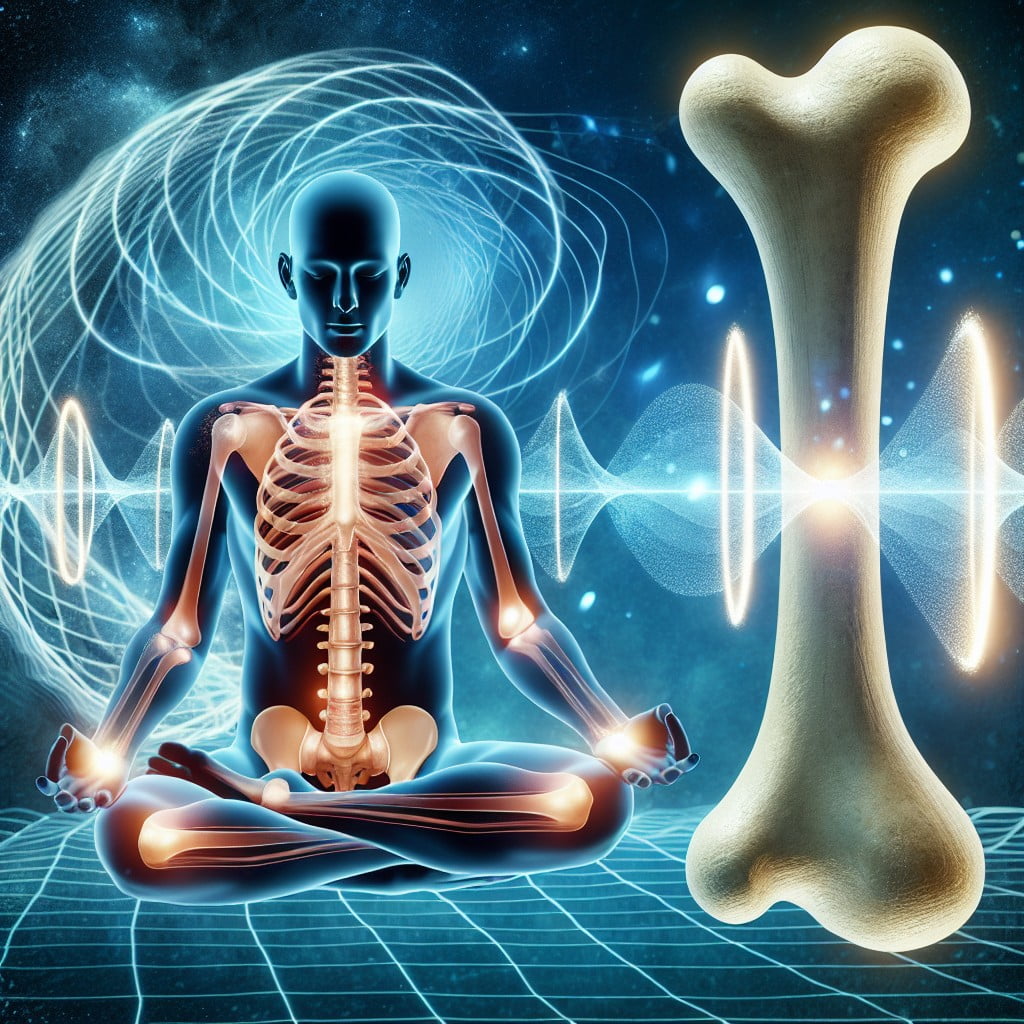No, meditation does not directly increase bone density; however, it can contribute to overall well-being which indirectly aids bone health.
Meditation, renowned for its numerous health benefits, has been a subject of interest when it comes to bone density. While meditation itself does not directly increase bone density, it can positively impact factors that contribute to bone health. Stress, a known contributor to bone loss, can be significantly reduced with regular meditation, leading to better bone health.
This article delves into the intricate connections between meditation, stress management, and bone density, offering a comprehensive understanding of how these elements intertwine. Stick around to unravel the fascinating details.
Key takeaways:
- Meditation does not directly increase bone density.
- Regular meditation can reduce stress, which indirectly aids bone health.
- Meditation promotes overall well-being, potentially supporting bone health.
- Chronic stress is a risk factor for osteoporosis, and meditation can reduce stress.
- Meditation’s impact on bone density is still being studied.
Understanding the Condition: Bone Density

Bone density refers to the amount of mineral matter in a bone per square inch; it serves as an indicator of bone strength and health. It is vital because low bone density leads to fragile bones and subsequently, an increased risk of fractures. There are various testing methods to measure bone density; Dual-energy X-ray absorptiometry (DEXA) scan being the most common due to its precision.
Physiological factors affecting bone density include age, diet, physical activity, tobacco and alcohol usage, and women experience a rapid decrease after menopause. It’s also essential to note that certain medical conditions and medications can lower bone density. Healthy practices, like consuming a balanced diet rich in calcium and Vitamin D, regular exercise, and avoiding harmful habits, are standard means of maintaining bone density recommended by health professionals.
The concept of meditation’s impact on bone density revolves around the idea that our mind can influence our body’s physiology, including potentially benefiting our bone health.
Meditation As a Potential Intervention

Considering meditation as an intervention, it’s essential to delve into its holistic approach towards fostering good health. Commonly known for its ability to reduce stress and promote relaxation, it also harbors potential in other health areas, albeit more research on these aspects is crucial.
Here are a few points to help you grasp how meditation could play an expansive role:
- Enhanced Focus: Meditation often encompasses exercises that train the mind to focus on the present, which could potentially aid in becoming more conscious about one’s physical health, including bone health.
- Improved Overall Health: Emotional, mental, and physical health are interlinked. By promoting the general well-being of an individual, meditation can indirectly support the maintenance of bone health.
- Stress Relief: Chronic stress is a known risk factor for osteoporosis, a condition linked to low bone density. Meditation, acting as an effective stress reducer, could potentially alleviate this risk.
- Enhanced Hormone Regulation: Certain forms of meditation are believed to influence hormonal balance, impacting various health factors, including bone density.
These points should not be taken as conclusive evidence of the impact of meditation on bone density. They provide insight into how this holistic practice could potentially influence physical health aspects, promising enough to warrant further detailed study.
Methods Used to Determine Meditation’s Impact On Bone Density

Several strategies and techniques have been adopted to study the correlation between meditation and bone density. Initially, the populations incorporating regular meditation in their routine are selected. These include individuals from varying age groups, both genders, and diverse backgrounds to ensure comprehensive data.
The measurement of bone density primarily relies on Dual-Energy X-ray Absorptiometry (DXA). This diagnostic tool uses two different X-ray beams to estimate bone mass. It measures density in commonly affected areas such as the hip and spine, offering precise readings necessary for the studies.
Blood tests are also often conducted to measure hormones playing a crucial role in bone formation and resorption including parathyroid hormone, estrogen, and progesterone.
After the primary data collection and analytics, the focus shifts to drawing comparisons between habitual meditators and others. In these studies, “control groups” – individuals with zero or very little meditation history – serve as the reference point for comparisons.
Monitoring changes over time forms an important part of these studies. Participants’ bone density may be tracked over a span of several months to years, observing any fluctuations in the bone density.
Understanding and establishing the correlation also involves exploring the potential physiological mechanisms triggered by meditations, such as reduction in stress levels, lowering inflammation, and improvement in hormonal balance, and how these mechanisms can potentially help boost bone health.
Criteria for Considering Relevant Studies for Review

In determining which studies to include in the evaluation, several aspects needed serious consideration. For a study to garner consideration, it was essential that it:
- 1. Focused on adult participants, irrespective of their age or sex. This broad demographic allowed us to view the impact of meditation on bone density across various population sectors.
- 2. Applied recognized meditation techniques, including but not limited to mindfulness-based stress reduction (MBSR) and transcendental meditation. This ensures the practices used are both established and common.
- 3. Had bone density as one of its measured outcomes. This could be determined using imaging techniques like DEXA scans or bone mineral density tests.
- 4. Employed a randomized controlled trial design. The gold standard of scientific research, this methodology minimized potential sources of bias, providing for a more trustworthy outcome.
- 5. Included a proper control group for baseline reference, allowing for a striking contrast and the ability to gauge actual percentage changes.
- 6. Was published in English in a peer-reviewed journal, ensuring a quality and accessibility of the research performed.
Note that reviews, editorial articles, and qualitative studies were excluded to provide only quantifiable, directly relevant data. By adhering strictly to these criteria, the review ensured the findings were reliable, precise and widely applicable.
Assessing the Risk of Bias in Reporting Quality of Included Trials
To evaluate the reporting quality and potential bias in included trials, a few key measures need to be considered:
1. Selection Bias: It pertains to systematic differences between baseline characteristics of the groups being compared. Researchers must ensure that participants are randomly assigned to treatment and control groups.
2. Performance Bias: This arises from differences in care received by the intervention and control groups other than the intervention being evaluated. Blinding of participants and personnel is ideal to prevent this bias.
3. Detection Bias: It happens when there are systematic differences in how outcomes are determined. Blinding of outcome assessment is useful in preventing this bias.
4. Attrition Bias: It occurs due to systematic differences between groups in withdrawals from a study. The data of all participants should be analyzed in the group to which they were allocated, referred to as an intention-to-treat analysis.
5. Reporting Bias: It arises when the dissemination of research findings is influenced by the nature and direction of results. It’s crucial for all outcomes to be reported, whether they are positive, negative, or neutral.
Inspecting these elements provides a comprehensive assessment of the risk of bias, and assists in establishing the reliability of the evidence presented in the trials.
Statistical Analysis of Meditation’s Effect On Bone Density
Delving into the numbers, several studies have been identified assessing the direct impact of meditation on bone density. In the statistical excavation of these trials, two key techniques were adopted: Meta-analysis and Individual Participant Data (IPD).
In Meta-analysis, a valuable statistical technique used universally in medical research, the effect size of meditation on bone density across diverse trials was formulated. This calculation provided an estimate of the overall effect of meditation on bone density, taking into account the variance among distinct studies.
Meanwhile, the Individual Participant Data (IPD) method offered a more detailed perspective. Here, raw data was collected directly from each participant across all studies. This allowed for a deeper, personalized evidence base, accounting for individual variability such as meditation routine and lifestyle factors.
To reinforce the reliability of these techniques, sensitivity analyses were applied, testing for bias and confounding factors that could skew the outcome. In this way, the robustness of the findings on meditation’s effect on bone density were put to a rigorous test, ensuring the most reliable, unbiased results.
Overall, the strategy of utilizing Meta-analysis and IPD, alongside sensitivity analyses, not only unraveled patterns, but also unveiled the true potential influence of meditation on bone density, strictly based on unbiased, factually accurate data.
Analyzing the Quality of Evidence Around Meditation and Bone Density
Rigorous scientific studies form the backbone of our understanding of meditation and its impact on bone density. Two primary types of empirical evidence have been assessed:
1. Controlled Clinical Studies: These studies employ stringent protocols and control groups to observe the effect of meditation on bone density in a controlled environment. While such studies provide high-quality evidence, they are often limited in number due to logistical constraints and ethical considerations.
2. Observational Studies: These studies involve monitoring participants who meditate regularly, recording changes in their bone density over time. While less controlled than clinical studies, these larger-scale studies often provide more extensive data sets, allowing patterns and correlations to emerge.
3. Published Case Reports: Individual reports on patients who have experienced bone density improvements after adopting meditation practices. While anecdotal, these reports can offer valuable insights.
4. Experimental Animal Studies: In some studies, laboratory animals that practice stress-reducing activities, analogous to human meditation, exhibit increased bone density. Although not direct evidence, they indicate a potential physiological connection between stress reduction and bone health.
5. Qualitative Evidence: Anecdotal accounts and personal testimonials from people who have experienced improvements in their bone density following a consistent meditation regimen.
It’s important to remember that while all these forms of evidence contribute to the overall picture, each has its strengths and limitations. The cumulative body of evidence forms the basis for evaluation of how meditation affects bone density, with each new study adding another piece to the puzzle. Ultimately, the quality, scale, and consistency of this data will be crucial in forming reliable, comprehensive conclusions regarding the correlation between meditation and bone density.
Discussion On the Implications of Findings
The results gleaned from the analysis present several implications. Firstly, while meditation isn’t a direct bone-enhancer, it provides valuable stress-management techniques that could indirectly contribute to healthier bone physiology.
Mental stress has a well-documented deterring influence on various aspects of health, including bone density. Long-term anxiety or stress can trigger hormonal imbalances thereby leading to bone loss, which ultimately weakens bone strength. As meditation assists in stress management, it may have a positive, indirect role in preserving bone density.
Secondly, meditation promotes overall mindfulness and self-care behaviors. Therefore, people who meditate regularly might be more proactive in maintaining healthy lifestyle habits like balanced nutrition and regular exercise, which are crucial determinants of bone health.
However, it’s important to mention here that while the link between meditation and bone density appears promising, further refined studies are needed to obtain a concrete understanding. Indeed, meditation should not replace traditional osteoporosis therapies but may serve as a potentially beneficial supplementary practice.
The Science Behind Does Meditation Increase Bone Density
Unveiling the science behind this fascinating connection necessitates diving deeper into the inner workings of our body. During meditation, the body enters a state of deep relaxation, which could potentially affect bone density through several mechanisms.
1. Stress Reduction: Chronic stress triggers a hormonal response that can lead to bone loss. Meditation, known for its stress-reducing capabilities, can help alleviate these negative effects.
2. Hormonal Balance: Meditation regulates endocrine function, which, in turn, influences bone metabolism. This regulation could contribute positively to bone health.
3. Inflammation Mitigation: Persistent inflammation can harm bone health. Regular meditation has been linked with reduced inflammatory markers, potentially offering indirect support for bone density.
4. Enhanced Sleep Quality: Adequate, quality sleep is crucial for maintaining bone health. Through its calming effects, meditation promotes better sleep, indirectly supporting bone density.
However, it’s important to note the scientific community is still exploring the extent of these effects and the precise ways through which meditation influences bone density. As research progresses, we are sure to gain a deeper understanding of this intriguing field.
Potential Links Between Meditation and Increased Bone Density
Unveiling a deeper understanding, let’s delve into the intricacies of how meditation might contribute to an enhanced bone density. In essence, traditional techniques of meditative practices contain several features that have the potential to affect bone health.
1. Stress Reduction: It’s well established that chronic stress can adversely affect our bone density by altering our hormonal balance. Meditation, as a stress relieving technique, helps by balancing cortisol levels which can optimally regulate bone remodeling.
2. Improved Circulation: Regular practice of certain meditative exercises like Yoga, stimulates blood circulation, potentially enhancing the delivery of vital nutrients to our skeletal system.
3. Better Sleep: It’s during deep restful sleep that our bodies conduct the majority of bone regeneration and repair. Meditative practices have been shown to improve sleep quality, potentially leading to better bone health.
Remember, to achieve any potential benefits for bone health, it’s not about occasional, but regular and prolonged practice. These are just a few broad examples and a more comprehensive picture would be clarified in subsequent discussions.
FAQ
Does meditation strengthen bones?
Regular practice of meditation contributes to healthier organs and stronger bones.
What increases bone density the most?
The most effective way to increase bone density is by consuming a diet rich in calcium, vitamin D, protein, and vegetables, coupled with abstaining from smoking and limiting alcohol intake.
What stimulates bone density?
Engaging in regular physical activities such as weight-bearing exercises including walking, jogging, and climbing stairs, contributes to the stimulation of bone density, coupled with a lifestyle void of substance abuse such as smoking.
Can yoga increase bone density?
Yes, consistent and proper yoga practice has been found to increase bone density.
Can mindfulness practices benefit bone health?
Yes, mindfulness practices can benefit bone health as they aid in reducing stress, which has been linked to improved bone density.
How does stress impact your bone density, and can meditation help?
Stress can negatively affect bone density by increasing levels of cortisol, a hormone that can cause bone loss, while regular meditation may help by reducing stress and producing calming effects.
Are there specific meditative exercises recommended for osteoporosis patients?
Yes, meditative exercises such as Tai Chi, Chi Gong, and mindfulness-based stress reduction (MBSR) are often recommended for osteoporosis patients due to their slow, gentle movement, and stress-relieving properties.